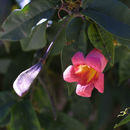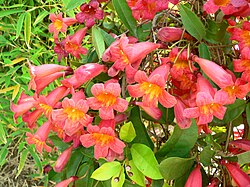zh-TW
在導航的名稱


Bignonia capreolata ist eine Pflanzenart aus der Gattung Bignonia innerhalb der Familie der Trompetenbaumgewächse (Bignoniaceae).[1]
Bignonia capreolata ist eine fast kahle Liane, deren Phloemstränge im Querschnitt der Sprossachse immer in einer Anzahl von Vielfachen von 4 auftritt. Die Zweige sind drehrund, unbehaart bis flaumig behaart.
Sie besitzen keine Drüsen, jedoch Linien zwischen den Blattstielen. Die Pseudonebenblätter sind krautig. Die gegenständigen und kurz gestielten Laubblätter sind dreizählig, wobei das mittlere Fiederblättchen zu einer vielgeteilten Ranke mit Haftscheiben umgebildet ist.[2] Die fast kahlen, eiförmigen bis verkehrt-eiförmig oder elliptischen Blättchen sind leicht herzförmig, ganzrandig, rundspitzig bis zugespitzt und bis 18 Zentimeter lang.[3]
Die seitenständigen Blütenstände sind kurze und von Tragblättern begleitete, wenigblütige Zymen.
Die großen, zwittrigen und gestielten Blüten sind zygomorph und fünfzählig mit doppelter Blütenhülle. Der kleine, bis 9 Millimeter lange und drüsig besetzte, fast kahle Kelch ist becherförmig, mit unregelmäßigen oder kaum vorhandenen Kelchlappen. Die Außenseite der bis 5 Zentimeter langen Krone[4] ist mattrot oder orange, die Innenseite ist gelb bis orange-rot. Die Kronblätter sind röhrig verwachsen mit kurzen Lappen, die lange an der Basis verengte Kronröhre ist gebogen und dick. Die vier didynamischen Staubblätter stehen nicht über die Krone hinaus, die Staubbeutel sind unbehaart und bestehen aus geraden Theken. Der oberständige und zweikammerige Fruchtknoten ist zylindrisch und schuppig bedeckt, die einzelnen Fruchtblätter enthalten zweireihig angeordnete Samenanlagen. Der knapp eingeschlossene Griffel trägt eine zweilappige Narbe.[3] Es ist ein Diskus vorhanden[2]
Die linealischen, abgeflachten und bis 20 Zentimeter langen, ledrig-holzigen, septiziden Kapselfrüchte sind mit Korkporen besetzt und unbehaart. Die flachen, braunen, zweilappigen Samen sind kahl und meist beidseits breit geflügelt. Sie sind mit den Flügeln bis 3 Zentimeter lang, der Fruchtkörper ist bis 1 Zentimeter lang.[3][4]
Innerhalb der Trompetenbaumgewächse (Bignoniaceae) wird Bignonia capreolata in die Tribus Bignonieae eingeordnet. Molekularbiologische Untersuchungen platzieren die Art zusammen mit Cydista, Clystostoma, Phryganocydia, Potamoganos, Saritaea, Roentgenia, Mussatia und einer Art der Gattung Tanaecium in die sogenannte Mimetic-Klade. Dieser Name bezieht sich darauf, dass angenommen wird, dass die Pflanzen keinen Anreiz für Bestäuber, beispielsweise in Form von Nektar, bereitstellen, sondern durch Mimikry oder Täuschung Bestäuber anlocken.[5]
Das Verbreitungsgebiet von Bignonia capreolata liegt in den zentralen und östlichen Vereinigten Staaten.[1]
Der Name Bignonia führt auf eine 1719 veröffentlichte Beschreibung in Joseph Pitton de Tourneforts Werk Institutiones Rei Herbariae zurück, die grob den Umfang der heutigen Familie der Trompetenblumengewächse (Bignoniaceae) umfasst. Carl von Linné übernimmt den Namen von Tournefort und anerkennt in seiner ersten Ausgabe von Species Plantarum (1753) und der fünften Ausgabe von Genera Plantarum (1754) zunächst 13 Arten innerhalb der Gattung Bignonia an. Er platziert diese in seinen Didynamia Angiospermia. In späteren Veröffentlichungen beschreibt Linné weitere Arten der Gattung. Der Gattungsname Bignonia ehrt den französischen Geistlichen und Hofprediger Ludwigs XIV. Jean-Paul Bignon (1662–1743).[6] Das Art-Epitheton capreolata bedeutet „rankend“, von capreolus, Ranke.[7]
Durch unterschiedliche Auffassungen über die Systematik innerhalb der Familie der Trompetenbaumgewächse (Bignoniaceae) variiert die Anzahl der den Bignonia zugerechneten Arten im Laufe der Zeit stark: Eine erste große Aufteilung der Gattung stammt von Antoine-Laurent de Jussieu in seinen Genera Plantarum von 1789, in der er die bis dahin beschriebenen Bignonia in verschiedene Gattungen teilt. Durch weitere Neuentdeckungen und systematische Umgruppierungen werden der Gattung 1802 durch Carl Ludwig Willdenow jedoch bereits 54 Arten zugerechnet; in der ersten großen Monographie der Familie Bignoniaceae durch Augustin-Pyrame de Candolle (1845 posthum veröffentlicht) sind es sogar 173 Arten. Eine bessere Unterteilung der Familie in Gattungen ist die von George Bentham und Joseph Dalton Hooker in deren Genera Plantarum, die jedoch keine Artenanzahl nennen. Die Gattung Bignonia im Sinne dieser Veröffentlichung wird jedoch von Karl Moritz Schumann in den Abhandlungen über die Familie in den Natürlichen Pflanzenfamilien (1894) und der Flora Brasiliensis (1896–1897) in weitere kleinere Gattungen geteilt.
Bignonia capreolata ist eine Pflanzenart aus der Gattung Bignonia innerhalb der Familie der Trompetenbaumgewächse (Bignoniaceae).
Bignonia capreolata is a vine commonly referred to as crossvine.[2] The common name refers to the cross-shaped pattern revealed when the stem is cut; this pattern results from four radial wedges of phloem embedded within the stem's xylem.[3] It is native to the central and southern United States.[4] The vine climbs without twining but does produce tendrils. It produces long tubular flowers which are red and yellow and frequently have a mocha fragrance.[5] The leaves are dark green to almost purple and produced as opposite pairs with terminal tendrils. The vine often climbs very high, with leaves only remaining on the uppermost portion of the plant. Crossvine can spread aggressively through stolons and may need to be managed in garden or domestic settings.[6]
There was for some time confusion surrounding the name of this plant, which was apparently sometimes referred to as "Bignonia crucigera", a name more properly referring to a different plant altogether.[7]
One 18th century report describes a medicinal use for cross-vine by the Cherokee people:
"The vines or climbing stems of the climber (Bigonia Crucigera) are equally divided longitudinally into four parts by the same number of their membranes somewhat resembling a piece of white tape by which means, when the vine is cut through and divided traversely, it presents to view the likeness of a cross. This membrane is of a sweet, pleasant taste. The country people of Carolina crop these vines to pieces, together with china brier and sassafras roots, and boil them in their beer in the spring, for diet drink, in order to attenuate and purify the blood and juices. It is a principal ingredient in Howard's famous infusion for curing the yaws, etc., the virtues and use of which he obtained from Indian Doctors."[8]
In 2012, researchers at Bastyr University published a paper revealing that they had identified the indole alkaloid reserpine in Crossvine.[9]
Bignonia capreolata is a vine commonly referred to as crossvine. The common name refers to the cross-shaped pattern revealed when the stem is cut; this pattern results from four radial wedges of phloem embedded within the stem's xylem. It is native to the central and southern United States. The vine climbs without twining but does produce tendrils. It produces long tubular flowers which are red and yellow and frequently have a mocha fragrance. The leaves are dark green to almost purple and produced as opposite pairs with terminal tendrils. The vine often climbs very high, with leaves only remaining on the uppermost portion of the plant. Crossvine can spread aggressively through stolons and may need to be managed in garden or domestic settings.
There was for some time confusion surrounding the name of this plant, which was apparently sometimes referred to as "Bignonia crucigera", a name more properly referring to a different plant altogether.
La Bignonia capreolata L., 1753 è una specie di pianta appartenente al genere della Bignonia, originaria del sud-est degli Stati Uniti.
Si tratta di una specie sempreverde, particolarmente vigorosa, che cresce molto rapidamente fino a raggiungere anche i 10 metri di altezza. In Italia cresce all'aperto nelle regioni più calde del centro e del sud del paese, mentre al nord viene coltivata nelle serre o all'aperto nelle zone dove il clima è più mite per tutto il periodo dell'anno.
Le foglie sono ovali, oblunghe e dentate, di colore verde lucido in primavera e d'estate e rosse in autunno, e si sviluppano a coppie simmetricamente rispetto al ramo. È oltretutto una pianta rampicante, che si "aggrappa" con delle ventose che si trovano al termine dei viticci ramificati delle foglie.
I fiori, di color rosso-arancio, sono raggruppati in cime peduncolate e possiedono una corolla tubulosa lunga circa 4 o 5 centimetri che termina con cinque lobi allargati. Sono molto visitati dalle api.
La Bignonia capreolata L., 1753 è una specie di pianta appartenente al genere della Bignonia, originaria del sud-est degli Stati Uniti.
Bignonia capreolata là một loài thực vật có hoa trong họ Chùm ớt. Loài này được L. mô tả khoa học đầu tiên năm 1753.[1]
Bignonia capreolata là một loài thực vật có hoa trong họ Chùm ớt. Loài này được L. mô tả khoa học đầu tiên năm 1753.

ツリガネカズラ(釣鐘葛、Bignonia capreolata)は、アメリカ中南部原産のノウゼンカズラ科の蔓性低木である。 壁面緑化などの園芸用として栽培される。
蔓性の低木で、茎は壁や塀やフェンスや樹木など周囲にあるものに沿って高く這い上がる。茎で巻き付くだけではなく、巻きひげにツタのような吸盤を持っているため、巻き付くことができないような壁面にも這い上がることができる。葉は常緑性で三出複葉とされるが、頂小葉は巻きひげに変化しているため、小葉は二枚しかないように見える。
夏には5cm程度の筒状花を多数つける。原種の花は花筒の外部が赤褐色で内部が黄色になるが、園芸種にはピンクになるものもある[1]。
壁を這い上がるため、建物や崖などの壁面緑化に利用される。花に独特の匂いがあり、モカの匂いと言われる[2]。また、日本ではこの匂いと花の色からカレーを連想して、カレーバインもしくはカレーカズラなどと呼ぶこともある。